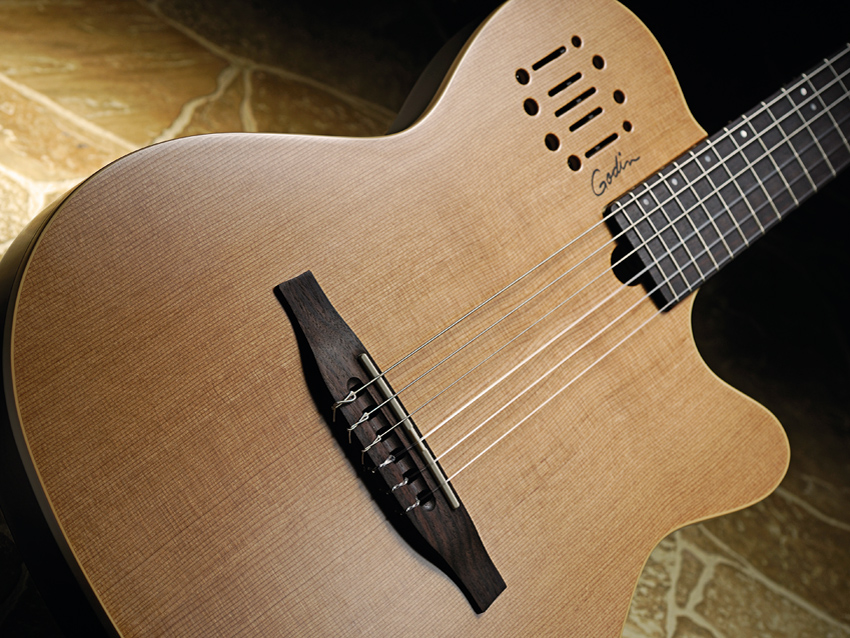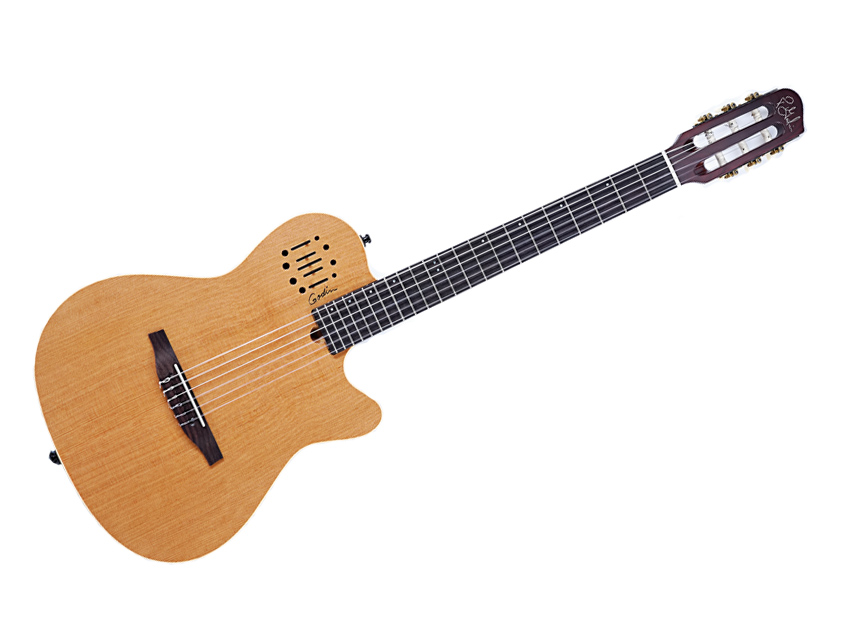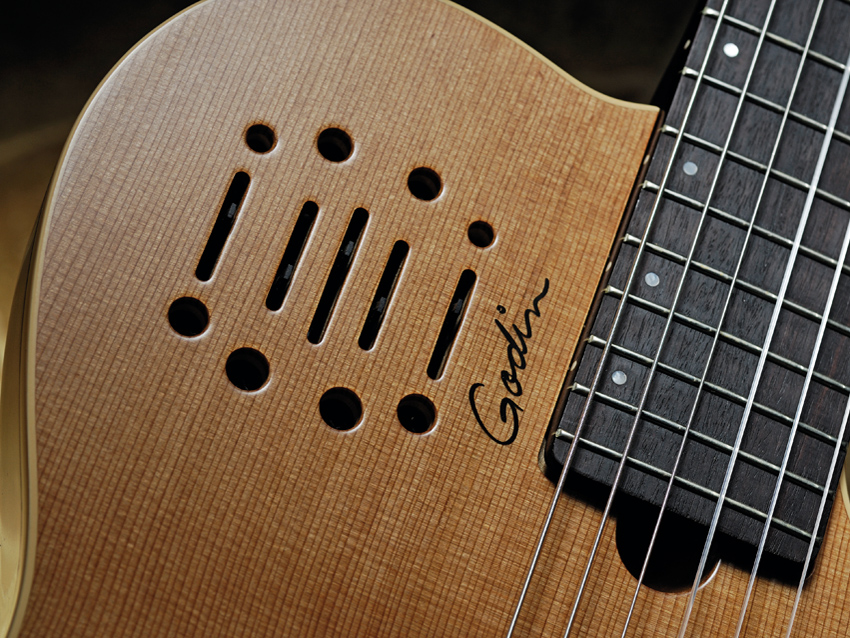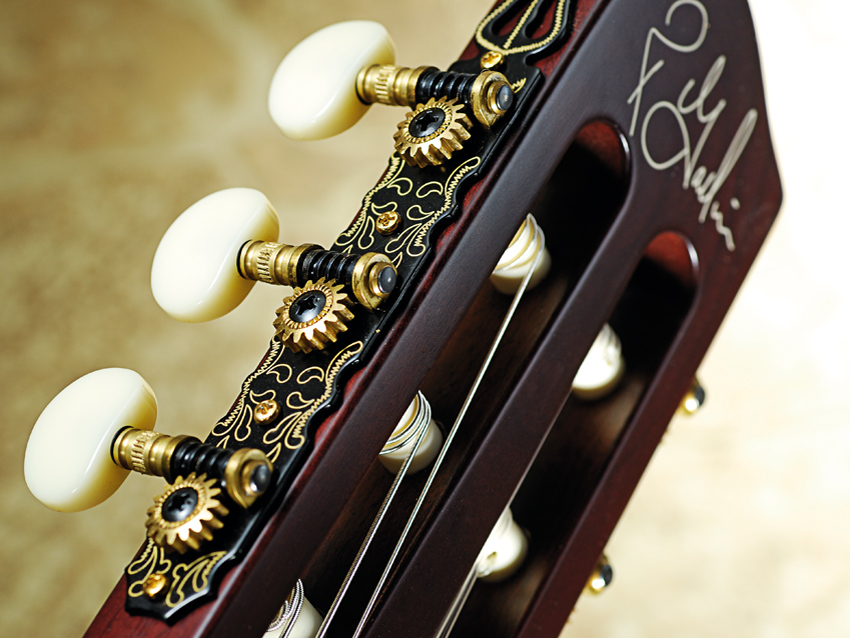MusicRadar Verdict
A versatile guitar with realistic amplified sounds - a great addition.
Pros
- +
Design. Competent build. Feedback rejection. Blendable sounds. EQ.
Cons
- -
Nothing.
MusicRadar's got your back

Godin Multiac Encore Nylon

Godin Multiac Encore Nylon

Godin Multiac Encore Nylon

Godin Multiac Encore Nylon
Mention nylon strings and thoughts tend to turn to classical guitar. It needn't be the case, especially with Godin. Classical purists are served well by the brand and its 12-frets-to-the-body Grand Concert Multiacs, which have a virtually flat fingerboard and 51mm (two-inch) wide nut.
See the Godin Multiac Encore Nylon in action:
This one, however - the Encore - appeals to players crossing over from steel strings. As such, it has a reduced nut width, a more cambered fingerboard and the neck joins the body between the 15th and 16th frets.
"The Multiac has a lot more give and projection than its solidbody-like dimensions would suggest."
The Encore's body is 360mm wide, 440mm long and just 48mm deep. Almost hollow, it has back and sides cut from silver leaf maple, generously radiused back edges and a slight ribcage cut. The cedar top is quite wide-grained and is edge- bound with cream plastic.
Internally, the top has a large cross brace under the bridge, which sits over five fan braces, while the back has three thicker cross braces. All the bracing and strutting is spruce and nicely tidy.
The bridge, like the fretboard, is rosewood and has a Tusq-compensated saddle, which mirrors the nut material.
The neck is well proportioned with a flattish 'D' profile, topped by a slotted headstock. As with many modern nylon-string guitars, there's a truss rod, adjustable at the body end. Along with the four-screw attachment, it's certainly more flexible than a conventional nylon-string classical design.
The Multiac's distinctive upper shoulder control area features eight mini sound ports and five slider controls: master volume, treble, mid, bass (the EQs are centre-notched for flat response positions) and blend.
At its lowest point, the blend slider voices only the undersaddle piezo, but as you move it upwards towards the headstock it introduces the dual soundboard transducers that are placed bass- and treble-side under the top, below the bridge.
The active preamp is powered by a single 9V battery (in its own rear flip-top cavity), the mono output jack is on the body's edge, as with a Telecaster, and there are regularly placed Schaller strap lock-style buttons.
Sounds
Unplugged, not surprisingly, the Encore has a quiet acoustic tone, but one that's perfectly useful for practice. It also has a lot more give and projection than its solidbody-like dimensions suggest.
Plugged in, with the EQs set flat, things sound a touch more realistic. There's quite a lot of crisp presence, especially with the soundboard transducers in play. In fact, you may need to tone down your amp or PA settings as, even with the treble slider fully down, that high, crisp edge is audible.
The mid-range slider also benefits from some reduction to avoid the output sounding over- hard, especially for more percussive Latin styles.
With occasional help from the presence control on our test AER Compact Classic combo, we manage to pull a selection of styles out of the bag using the guitar's onboard EQ.
Crisp flamenco, smoother jazz styles, new-age scooped and effected arpeggios and percussive African voices, which can actually sound quite like steel strings, are all possible.
Over a couple of gigs, the Encore really proved its worth. On stage, with a big PA and vicious monitors, it edged into feedback but in more usual circumstances that isn't an issue.
At higher volumes, the piezo is the best option to avoid handling noise and feedback but in the studio, and at more sedate gigs, the soundboard transducers add realism.
If you're not going to perform, then you don't need to own this guitar. In fact, even if your gigs are limited to small venues you could survive with one of the seemingly thousands of standard nylon electros out there.
Where the Encore comes into its own is at those difficult shows, especially with a full band, when issues such as loud monitors or little or no soundcheck time can make a full acoustic a difficult proposition.
But this hybrid steel-meets-nylon design is not only highly practical, it's also classy looking and has an appealing feel - plus some excellent and highly adaptable, realistic sounds.
Dave Burrluck is one of the world’s most experienced guitar journalists, who started writing back in the '80s for International Musician and Recording World, co-founded The Guitar Magazine and has been the Gear Reviews Editor of Guitarist magazine for the past two decades. Along the way, Dave has been the sole author of The PRS Guitar Book and The Player's Guide to Guitar Maintenance as well as contributing to numerous other books on the electric guitar. Dave is an active gigging and recording musician and still finds time to make, repair and mod guitars, not least for Guitarist’s The Mod Squad.
“Every note counts and fits perfectly”: Kirk Hammett names his best Metallica solo – and no, it’s not One or Master Of Puppets
Ranked: Bon Iver's albums, from Sable, Fable to For Emma, Forever Ago
“Its mission is simple: unleash the power of any amplifier or line-level source without compromise”: Two Notes promises a “watershed” in tube amp control with the Torpedo Reload II










